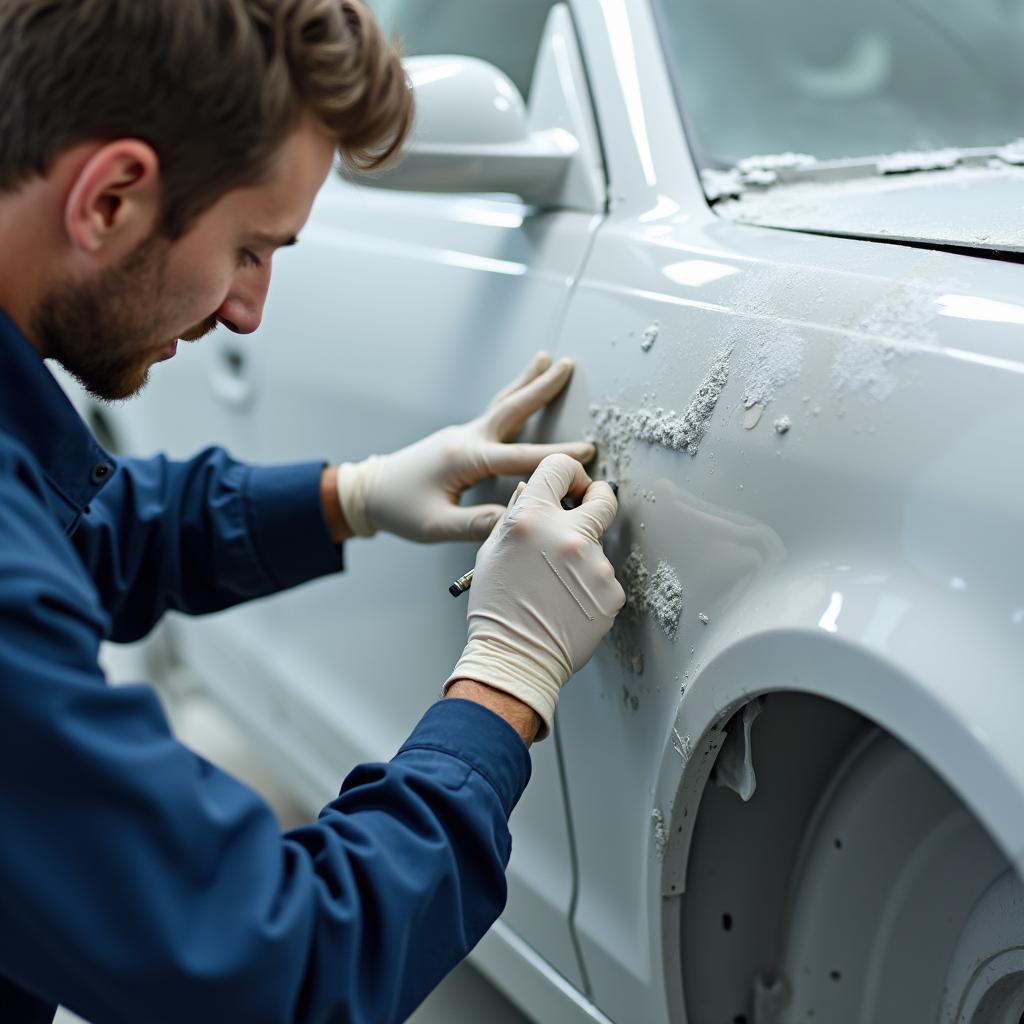Choosing the right car body repair materials is crucial for achieving a professional and long-lasting finish. With numerous options available in the UK market, it can be overwhelming to determine the best materials for your specific needs. This comprehensive guide will walk you through the different types of car body repair materials available in the UK, their applications, and factors to consider when making your selection.
Understanding Car Body Repair Materials
Car body repair materials encompass a wide range of products designed to restore the structural integrity and aesthetic appeal of a vehicle’s exterior. From minor scratches to significant collision damage, these materials play a vital role in bringing your car back to its pre-accident condition.
Types of Car Body Repair Materials Available in the UK
1. Body Filler
Body filler, also known as car body filler or putty, is a two-component product used to fill dents, scratches, and imperfections on car body panels. It typically consists of a resin paste and a hardener, which, when mixed, create a chemical reaction that hardens the filler.
Types of Body Filler:
- Polyester Body Filler: This is the most common type of body filler, known for its fast curing time and ease of sanding.
- Fiberglass Body Filler: This filler is reinforced with fiberglass strands, making it ideal for larger repairs and areas requiring greater strength.
- Epoxy-Based Body Filler: Known for its superior adhesion and resistance to moisture, solvents, and chemicals, making it suitable for repairs in demanding environments.
2. Primer
Primer acts as a bonding agent between the bare metal or body filler and the paint. It helps to prevent rust, provide a smooth surface for paint adhesion, and enhance the color and durability of the final paint job.
Types of Primer:
- Epoxy Primer: An excellent corrosion-resistant primer ideal for bare metal surfaces.
- Urethane Primer: Offers excellent adhesion and filling properties, making it suitable for use over body filler.
- Self-Etching Primer: Contains an acidic component that etches the metal surface, promoting strong adhesion for subsequent layers.
3. Paint
Car paint is a multi-layered system designed to protect the vehicle’s body and provide a desired finish.
Types of Car Paint:
- Acrylic Lacquer: An older type of paint that is affordable but less durable.
- Acrylic Enamel: More durable than lacquer and provides a glossy finish.
- Urethane: Known for its excellent durability, gloss retention, and resistance to fading and chipping.
- Water-Based Paint: Environmentally friendly option with lower VOC emissions.
4. Clear Coat
Clear coat is a transparent layer applied over the base coat to protect the paint from UV rays, scratches, and environmental contaminants. It enhances the gloss and depth of the paint, providing a showroom-quality finish.
5. Abrasives
Abrasives are essential for smoothing and preparing surfaces during various stages of car body repair. Sandpaper, sanding discs, and polishing pads are commonly used abrasives.
Choosing the Right Abrasives:
- Grit Size: The grit size determines the coarseness of the abrasive. Lower grit numbers indicate coarser abrasives used for initial shaping and removing material. Higher grit numbers indicate finer abrasives used for smoothing and polishing.
- Type of Abrasive Material: Aluminum oxide, silicon carbide, and ceramic are common abrasive materials, each with its properties.
Factors to Consider When Choosing Car Body Repair Materials in the UK
- Type and Extent of Damage: Different materials are suitable for different types of damage.
- Material Compatibility: Ensure the chosen materials are compatible with each other and the existing car body materials.
- Skill Level: Some materials require specialized skills and equipment to apply correctly.
- Environmental Conditions: Consider the drying time and temperature requirements of the materials based on the local climate.
- Budget: Car body repair materials come in a wide price range. Determine your budget and choose materials that offer the best value for your needs.
FAQs about Car Body Repair Materials in the UK
1. Can I use any body filler for car repairs?
While various body fillers are available, choosing the right type based on the repair’s size and location is crucial. For instance, fiberglass body filler is ideal for larger repairs requiring greater strength, while a lightweight filler is suitable for minor dents.
2. Is primer always necessary before painting?
Yes, using a primer is crucial as it promotes paint adhesion, prevents rust, and ensures a smooth and even paint finish.
3. Can I mix and match different brands of car body repair materials?
While it’s generally not recommended to mix different brands, especially for chemically curing products like body filler and paint, you can consult with a professional or refer to the manufacturer’s guidelines for compatibility information.
Need Help With Your Car Body Repair in the UK?
Finding the right car body repair materials and ensuring their proper application is essential for a successful repair. If you need assistance or have questions, don’t hesitate to reach out. We’re here to help you navigate the world of car body repair. You can check out our guide to car body diy repairs uk or browse our selection of car body repair tools uk for all your DIY needs.
Remember, selecting the appropriate car body repair materials and following the correct procedures will ensure a high-quality repair that restores your car’s appearance and protects its value for years to come.



